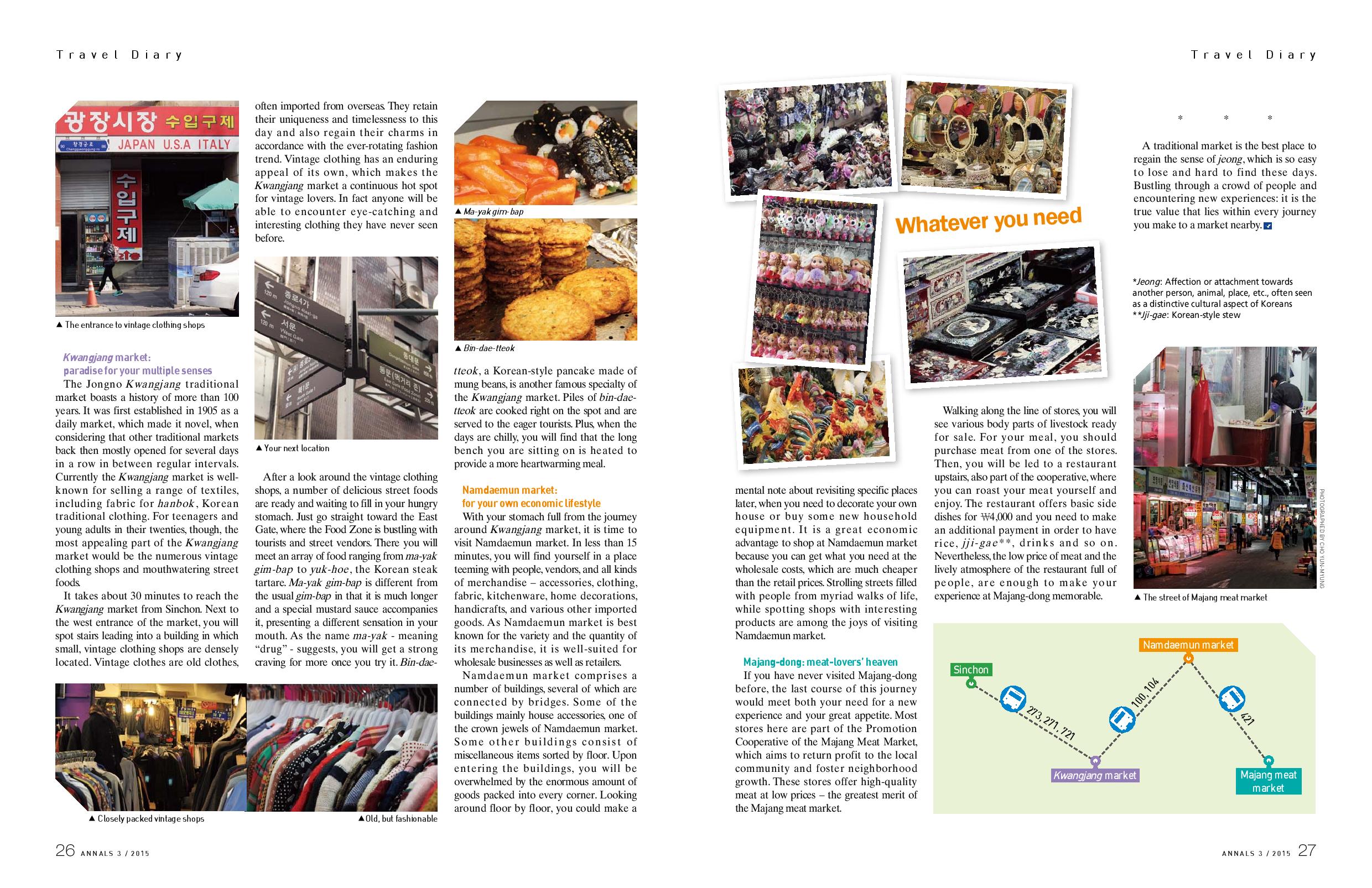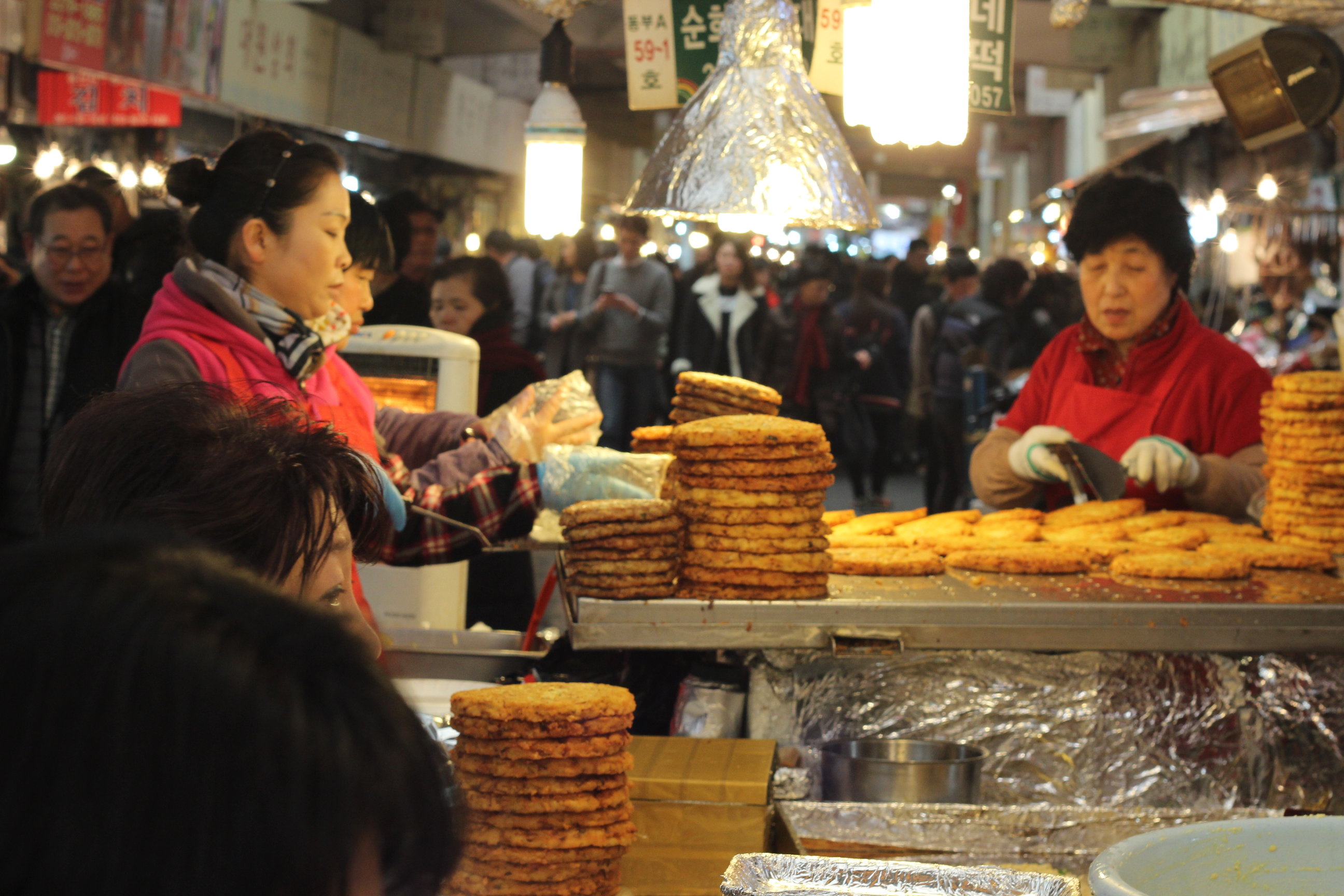A stroll through Korean traditional markets in Seoul


WHEN TRAVELING to another country or region, it is common to visit the most famous markets. Markets are indeed where people can feel the pulse of a particular region, as well as take a fascinating look at what people eat and how they live. Poking around alleyways and discovering one’s own precious route encompassing numerous hidden places is a great fun for anyone. Best of all, you need not go far for this experience: Seoul has a number of markets most exciting to explore.
Kwangjang market: paradise for your multiple senses
The Jongno Kwangjang traditional market boasts a history of more than 100 years. It was first established in 1905 as a daily market, which made it novel, when considering that other traditional markets back then mostly opened for several days in a row in between regular intervals. Currently the Kwangjang market is well-known for selling a range of textiles, including fabric for hanbok, Korean traditional clothing. For teenagers and young adults in their twenties, though, the most appealing part of the Kwangjang market would be the numerous vintage clothing shops and mouthwatering street foods.
It takes about 30 minutes to reach the Kwangjang market from Sinchon. Next to the west entrance of the market, you will spot stairs leading into a building in which small, vintage clothing shops are densely located. Vintage clothes are old clothes, often imported from overseas. They retain their uniqueness and timelessness to this day and also regain their charms in accordance with the ever-rotating fashion trend. Vintage clothing has an enduring appeal of its own, which makes the Kwangjang market a continuous hot spot for vintage lovers. In fact anyone will be able to encounter eye-catching and interesting clothing they have never seen before.
After a look around the vintage clothing shops, a number of delicious street foods are ready and waiting to fill in your hungry stomach. Just go straight toward the East Gate, where the Food Zone is bustling with tourists and street vendors. There you will meet an array of food ranging from ma-yak gim-bap to yuk-hoe, the Korean steak tartare. Ma-yak gim-bap is different from the usual gim-bap in that it is much longer and a special mustard sauce accompanies it, presenting a different sensation in your mouth. As the name ma-yak - meaning “drug” - suggests, you will get a strong craving for more once you try it. Bin-dae-tteok, a Korean-style pancake made of mung beans, is another famous specialty of the Kwangjang market. Piles of bin-dae-tteok are cooked right on the spot and are served to the eager tourists. Plus, when the days are chilly, you will find that the long bench you are sitting on is heated to provide a more heartwarming meal.
Namdaemun market: for your own economic lifestyle
With your stomach full from the journey around Kwangjang market, it is time to visit Namdaemun market. In less than 15 minutes, you will find yourself in a place teeming with people, vendors, and all kinds of merchandise –accessories, clothing, fabric, kitchenware, home decorations, handicrafts, and various other imported goods. As Namdaemun market is best known for the variety and the quantity of its merchandise, it is well-suited for wholesale businesses as well as retailers.
Namdaemun market comprises a number of buildings, several of which are connected by bridges. Some of the buildings mainly house accessories, one of the crown jewels of Namdaemun market. Some other buildings consist of miscellaneous items sorted by floor. Upon entering the buildings, you will be overwhelmed by the enormous amount of goods packed into every corner. Looking around floor by floor, you could make a mental note about revisiting specific places later, when you need to decorate your own house or buy some new household equipment. It is a great economic advantage to shop at Namdaemun market because you can get what you need at the wholesale costs, which are much cheaper than the retail prices. Strolling streets filled with people from myriad walks of life, while spotting shops with interesting products are among the joys of visiting Namdaemun market.
Majang-dong: meat-lovers’ heaven
If you have never visited Majang-dong before, the last course of this journey would meet both your need for a new experience and your great appetite. Most stores here are part of the Promotion Cooperative of the Majang Meat Market, which aims to return profit to the local community and foster neighborhood growth. These stores offer high-quality meat at low prices –the greatest merit of the Majang meat market.
Walking along the line of stores, you will see various body parts of livestock ready for sale. For your meal, you should purchase meat from one of the stores. Then, you will be led to a restaurant upstairs, also part of the cooperative, where you can roast your meat yourself and enjoy. The restaurant offers basic side dishes for 4,000 and you need to make an additional payment in order to have rice, jji-gae**, drinks and so on. Nevertheless, the low price of meat and the lively atmosphere of the restaurant full of people, are enough to make your experience at Majang-dong memorable.
* * *
A traditional market is the best place to regain the sense of jeong, which is so easy to lose and hard to find these days. Bustling through a crowd of people and encountering new experiences: it is the true value that lies within every journey you make to a market nearby.
*Jeong: Affection or attachment towards another person, animal, place, etc., often seen as a distinctive cultural aspect of Koreans
**Jji-gae: Korean-style stew
Cho Yun-myung
yunc39@yonsei.ac.kr

